Photography has no rules. There are no definitives, no "best". Lenses, housings, cameras, and lights are just tools for different jobs.
My preferred setup underwater includes a super-wide lens. My preferred lenses are the Tokina 10-17mm Fisheye and an 8-15mm Fisheye (Canon or Nikon). I've shot lots of rectilinear lenses as well, so I will try to explain why I choose to use fisheyes exclusively. As well as why some people, well... hate them.
The distortion caused by a fisheye can be used to creative advantage even when shooting models. This image is a composite of two split shots.
The Downsides of a Fisheye
Let's start with the negatives of fisheye lenses. Many a photographer has gone to the camera store and tried a super wide rectilinear lens, then compared it to a similar focal length fisheye. Considering that the focal length is the same, the difference visually is staggering. The distortion of a fisheye lens makes the counters, the ceiling, and every straight line look bizarre, even unpleasant. So many people will then opt for the rectilinear lens. This is valid, but more complex than it might seem.
There are wedding photographers using fisheyes. They are always careful to make sure the bride and groom's faces are near the center of the frame, where the distortion isn't noticeable. The stretch of the gown and surrounding scene can be quite nice. But the fisheye can make your subject (especially familiar ones you've seen often) look less "natural."
There are few parallel or perpendicular lines in nature. The "distortion" of the fisheye is in more of the underwater images you see published than you might expect. If it is one of my images, you can be pretty sure it was shot with a fisheye.
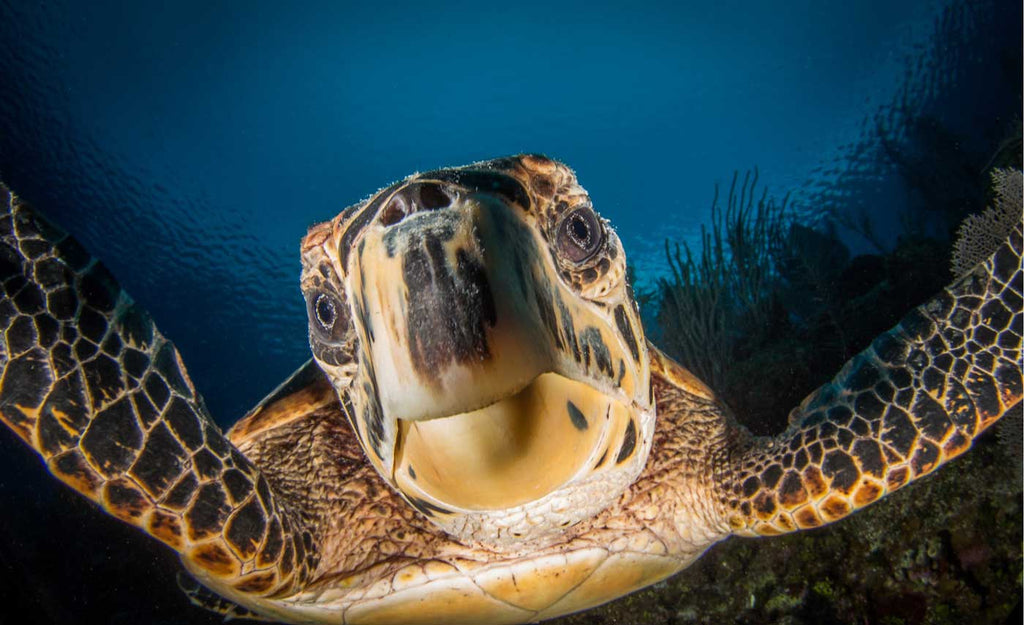
Minimum focus distance becomes a big issue when your subject is taking a nose dive into your dome port. The Tokina 10-17mm fisheye is capable of focusing on something only a few inches from the front of the lens.
Clarity and Close Focus Distance
A dome port is necessary to capture a super wide field of view without vignetting (dark shadows around the edges of the photo). And hands-down fisheye lenses work better behind dome ports than rectilinear lenses. A fisheye lens tends to have a closer minimum focus distance and better depth of field behind a dome port. The optical laws of refraction and dome size are a bit dry, so instead I'll share a true story.
My buddy and I bought the same Canon DSLR- identical systems, strobes, etc., with only one difference. He bought the Canon 12-24mm rectilinear, and I got the Tokina 10-17mm fisheye. We found ourselves with a turtle hatchling during a snorkel, that was fascinated by its reflection in the dome. He literally kept bumping the dome trying to get closer. We took turns shooting, because the turtle liked both domes equally (and nice photographers share their subjects). After a few minutes, my buddy asked if he could share my system, and set his down in the shallows. He had frame after frame at point blank, but the camera only locked focus and shot every few tries. The Tokina fired every time I pulled the shutter.

Even small turtle hatchlings can be photographed with a super wide fisheye lens. This curious turtle hatchling enjoyed seeing his own reflection in the dome port. I was able to get about 5x as many photos of it with my Tokina 10-17mm than my friend who was shooting a rectilinear lens.
All of the lenses in the super wide category (rectilinear or fisheye) offer amazing depth of field, and relatively close focus abilities. Either can be an excellent choice for close focus wide angle techniques, but many photographers focused on shooting reef-scapes are looking for the widest field of view that they can get. This will inevitably lead back to the fisheye.
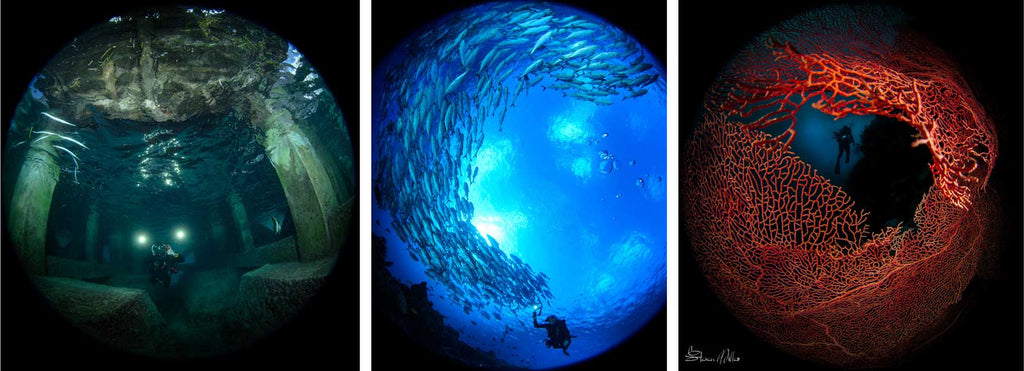
Magazine editors may not choose many circular fisheye images for print, but they are fun to shoot and the results can be quite stunning.
Split Shots and Circular Fisheye Lenses
Over-unders are the classic "split shot" where a portion of the image is above water and a portion underwater. Simply put: the wider the lens, the easier it is to make the capture. You will capture more of both sea and sky a focal length of 8mm than at 15mm.
Even in very still water, the waterline for these images is hard to control. A wider lens makes the waterline longer and narrower for a clean split.
So if you're like me and you want to shoot over-unders and have the widest view possible, you may end up looking at circular fisheyes. These lenses will typically range from 15mm and a rectangular shape, to 8mm at which point the view is so wide that your final image is circular. There are many photographers that don't like the circular shape (and many ad copy editors as well) but given the exceptions above, there are also many photographers that have used this to create stunning reef scenes.
All art is subjective, and so are lens choices. For this photographer, the 8-15mm lens is the finest I have ever used. The ability to capture the sky, the bottom, the sun, and the reef-scape all in the same frame brings me closer to what I am trying to express when diving on a beautiful reef with crystal clear water. A photograph can never convey the sense of space that the eye actually saw, but every millimeter helps make the story more complete.
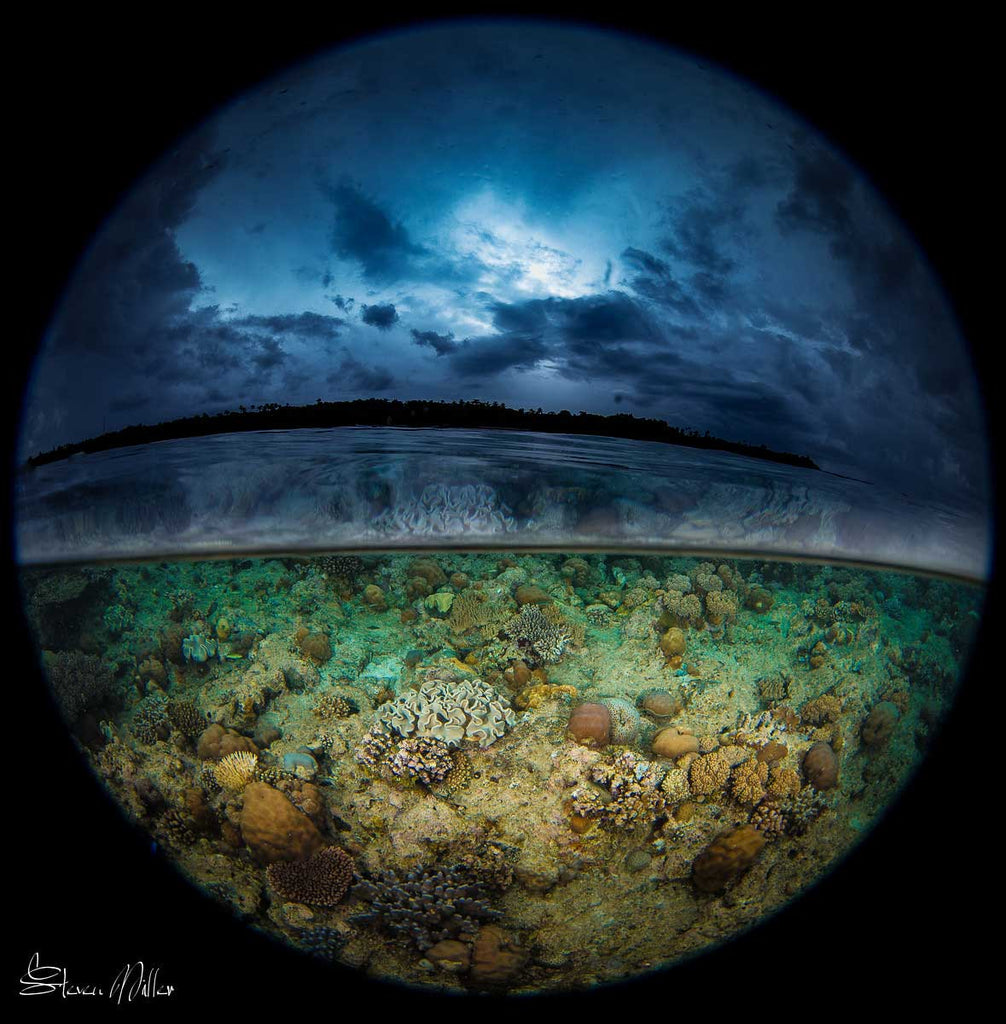
An 8mm circular fisheye allows you to capture a 180º field of view for a sweeping split shot from ocean floor to sunset.
Field Distortion with a Fisheye Lens
There are applications where the rectilinear lenses are preferred by more photographers... for good reason. At a recent DEMA conference Amos Nachoum (a very famous photographer of big animals) presented on shooting in the Arctic. He is adamant that a fisheye is the wrong lens for shots of swimming polar bears and big leopard seals. Amos argues that there is a realism produced from a rectilinear lens that the fisheye cannot accomplish. If you look at as many shark images as we do, you will start to see this sometimes "unflattering" effect. There are tools in Photoshop like "bloat" that are sometimes used to correct for this. Also, Lightroom has a lens correction tool that can be interesting.
If this unflattering angle can happen to a leopard seal, then it can certainly happen with a human model, since their shape is so much more familiar. Remember that saying about how a camera adds 10 pounds?

The bodies of larger animals like sharks and seals can become a little bloated when shooting a fisheye lens. But does it matter? This effect may not stand out to people who aren't used to looking at shark photos all day.
Shipwrecks and Man-Made Objects
Surely the best example of a rectilinear being more suitable that a fisheye is when man made shapes come into view. Docks and jetties, or any structure, can quickly turn into an artificial reef and a magnet for fish. Your fisheye lens will curve and bend the lines of the structure into something altogether different. The same holds true for shipwrecks. The sleek lines and shape of a (formerly) seafaring vessel will be distorted to varying degrees based on where you place them in the frame.

The straight man-made lines of the Wakatobi jetty bar are distorted by the fisheye lens.
Choosing a Port for Fisheye Lenses
Dome ports are categorized by diameter (or radius). This refers to the diameter of the sphere that the dome would be cut from. A larger diameter port produces sharper images underwater than a smaller diameter port. This sharpness is most apparent around the edges of the photo.

An 8" dome port is the industry standard for most wide angle lenses. It provides a good balance between image quality and ergonomics. These larger domes also offer some buoyancy that may be helpful depending on your system. When you are bobbing around on the surface trying to shoot over-unders, larger diameter domes make it easier to control your waterline.
Smaller, compact domes of 6" diameter or less tend to cause less wrist fatigue underwater since they are less buoyant. They are ideal for getting close to your subject when shooting close focus wide angle. And the reduced size and weight make them ideal for travel. Generally speaking, fisheye lenses will work better with the smaller domes than rectilinear lenses.
Fisheye lenses are typically more compact than rectilinear wide angle lenses, meaning shorter ports for your housing. This can improve underwater handling significantly and makes a big difference in reduction of drag when you're swimming around with your system.
Tips for Using a Fisheye Lens Underwater
I have heard fisheye lenses described as the easiest to use. I have also heard them described as the hardest. For me it is definitely the former: the narrower the view of my lens, the more frustrated I am.
If you're new to shooting with a fisheye lens, here are a few points to remember:
Always have something- anything- very close to the dome.
As close as a few inches away. It will take a while to be able to anticipate what the lens will do to this perspective, but this will come.
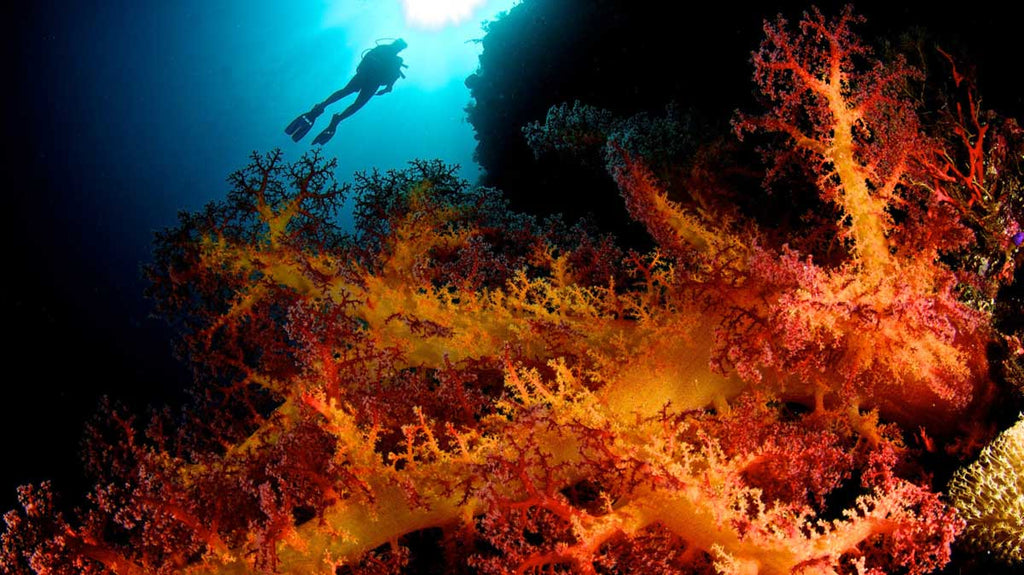
The beautiful soft corals in the foreground are very close to the front of the dome port- almost touching. The foreground is lit by TTL strobe exposure. The diver is too far away and becomes silhouetted in the background.
Keep your strobes behind the plane of the dome port.
Otherwise you may find two strobes peeking out of the edges of your photos once you transfer them to the computer.
Turn your strobes off sometimes.
If you are not close to an object (e.g. close focus wide angle) then turn your strobes off or away and shoot natural light.

Natural light photography is a great option when there's no subject to feature in the foreground.
Shoot at an upward angle.
This adds depth and perspective to your photos. You may even try shooting straight up to capture a cool effect called Snell's Window.
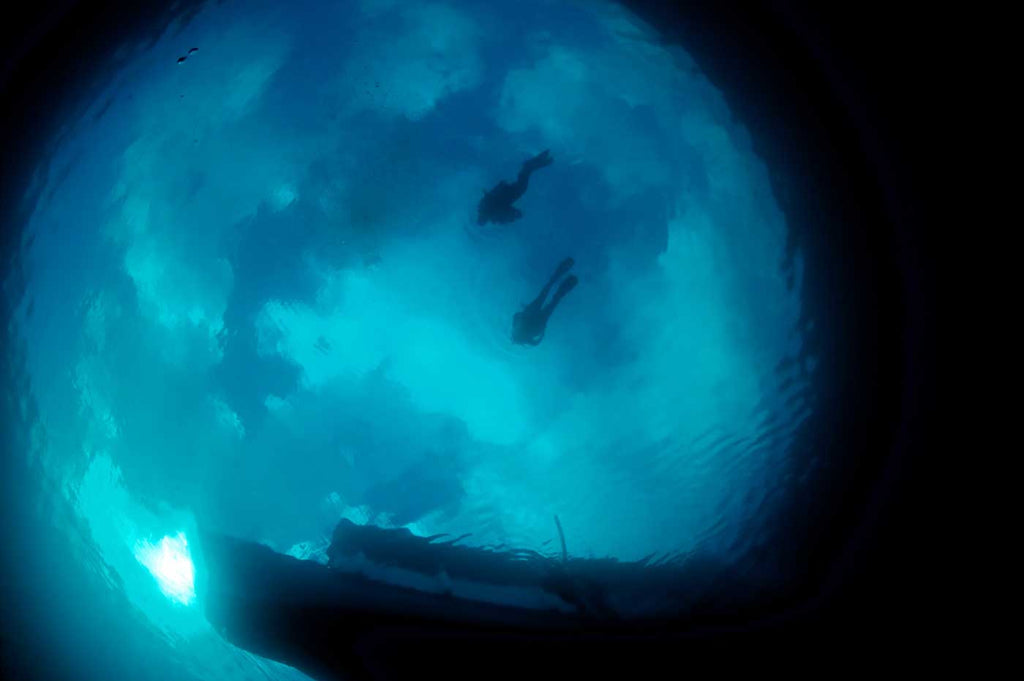
This is not a circular fisheye, it's a phenomenon called Snell's Window. It's a property of light that occurs when you shoot a super wide lens straight up towards the surface of the water.
Comparing Popular Wide Angle Lenses
| Lens | Type | Minimum Focus Distance | Weight | Length |
| Canon EF 8-15mm f/4L USM | Fisheye | 0.15 m (5.91") | 540 g (1.19 lb) | 83mm (3.27") |
| Nikon AF-S 8-15mm f/3.5-4.5E ED | Fisheye | 0.16 m (6.3") | 485 g (1.07 lb) | 83 mm (3.27") |
| Sigma 8-16mm f/4.5-5.6 DC HSM | Rectilinear | 0.24 m (9.45") | 555 g (1.22 lb) | 106 mm (4.16") |
| Nikon AF DX 10.5mm f/2.8G ED | Fisheye | 0.14 m (5.51") | 300 g (0.66 lb) | 63 mm (2.46") |
| Tokina AT-X 10-17mm f/3.5-4.5 DX | Fisheye | 0.14 m (5.51") | 350 g (0.77 lb) | 71 mm (2.8") |
| Sigma 10-20mm f/4-5.6 EX DC HSM | Rectilinear | 0.24 m (9.45") | 470 g (1.04 lb) | 81 mm (3.19") |
| Nikon AF-S DX 10-24mm f/3.5-4.5G ED | Rectilinear | 0.24 m (9.45") | 460 g (1.01 lb) | 87 mm (3.43") |
| Canon EF 16-35mm f/2.8L II USM | Rectilinear | 0.28 m (11.02") | 635 g (1.40 lb) | 112 mm (4.39") |
| Nikon AF-S 16-35 mm f/4G ED VR | Rectilinear | 0.28 m (11.02") | 685 g (1.51 lb) | 125 mm (4.92") |
| Sony FE 16-35mm f/2.8 GM | Rectilinear | 0.28 m (11.02") | 680 g (1.50 lb) | 122 mm (4.8") |
| Sony Vario-Tessar T* FE 16-35mm f/4 ZA OSS | Rectilinear | 0.28 m (11.02") | 518 g (1.14 lb) | 122 mm (4.8") |
A list of the most popular fisheye and rectilinear lenses for underwater use, in order by minimum focal length. Fisheye lenses are generally lighter, shorter, and have a closer minimum focusing distance- all advantages when shooting underwater.
Close focus wide angle is a fun an interesting technique to shoot when using a fisheye lens underwater. A rectilinear lens would struggle with the soft corals so close to the sides of the dome and may have trouble obtaining focus on the cuttlefish if it got any closer.
Conclusion
Fisheye lenses are not without their drawbacks, but they are fun to use and provide exceptional image quality underwater. If you're a fan of huge reef-scapes, over-unders, and close focus wide angle photography, then a fisheye lens is probably the right choice for you.
Having trouble deciding on a lens? Want to make the most of your next photo opportunity? We travel all over the world using the equipment and we're here to help you achieve your photographic goals.
Reach out to us any time for one-on-one advice. Just tell us what equipment you're shooting and where you're going. Even better, include a few images that you're particularly attracted to (but keep it clean).
 Ambassador Steve Miller has been a passionate teacher of underwater photography since 1980. In addition to creating aspirational photos as an ambassador, he leads the Ikelite Photo School, conducts equipment testing, contributes content and photography, represents us at dive shows and events, provides one-on-one photo advice to customers, and participates in product research and development. Steve also works as a Guest Experience Manager for the Wakatobi Dive Resort in Indonesia. In his "free" time he busies himself tweaking his very own Backyard Underwater Photo Studio which he's built for testing equipment and techniques. Read more...
Ambassador Steve Miller has been a passionate teacher of underwater photography since 1980. In addition to creating aspirational photos as an ambassador, he leads the Ikelite Photo School, conducts equipment testing, contributes content and photography, represents us at dive shows and events, provides one-on-one photo advice to customers, and participates in product research and development. Steve also works as a Guest Experience Manager for the Wakatobi Dive Resort in Indonesia. In his "free" time he busies himself tweaking his very own Backyard Underwater Photo Studio which he's built for testing equipment and techniques. Read more...
Additional Reading
Close Focus Wide Angle In Depth
How to Shoot Split Shots (Half-In, Half-Out of the Water)
Natural Light Photography Underwater
Snell's Window: A Wide Angle Photography Effect











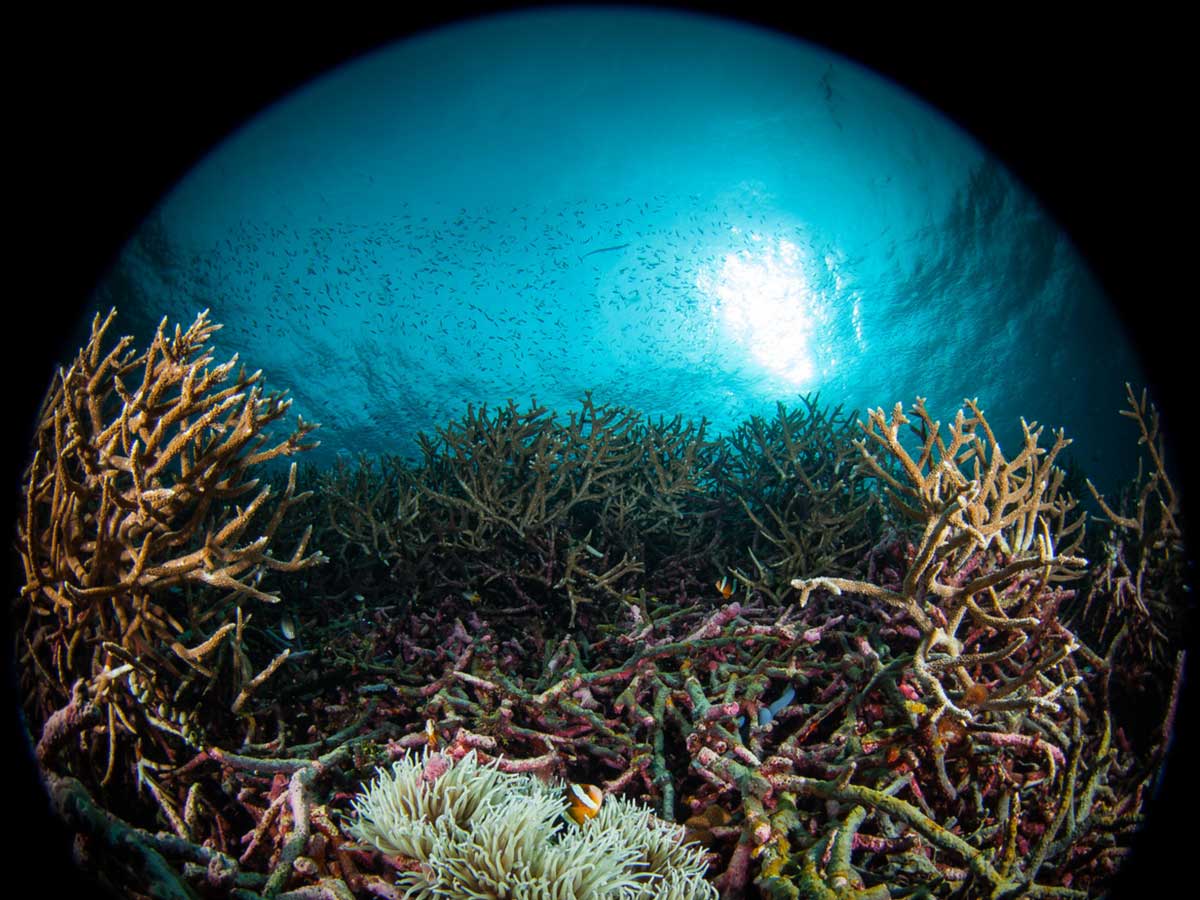

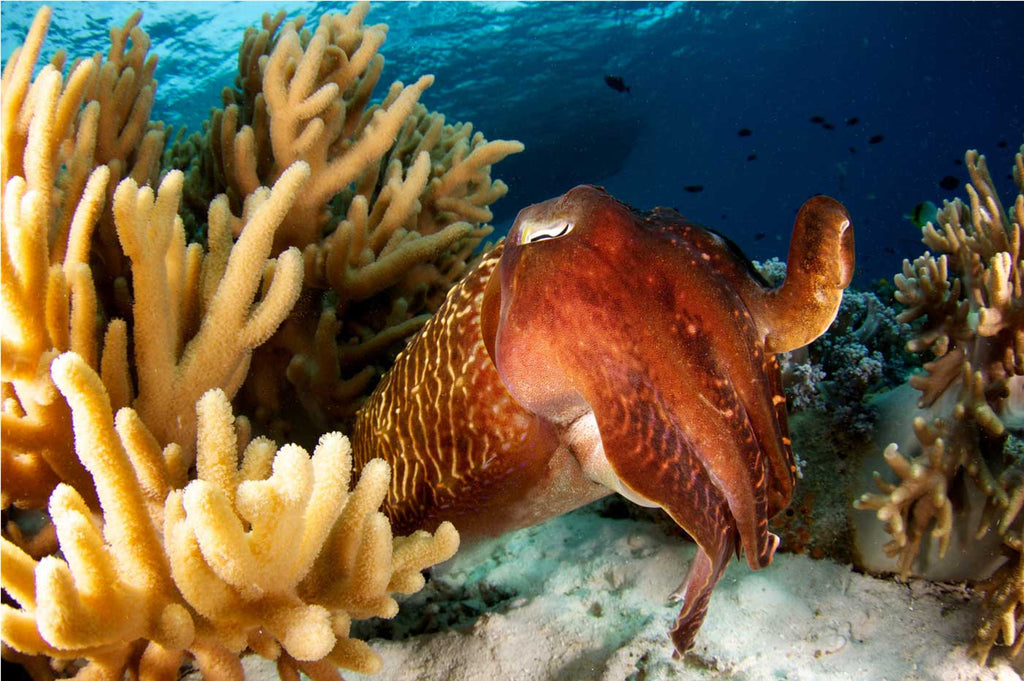
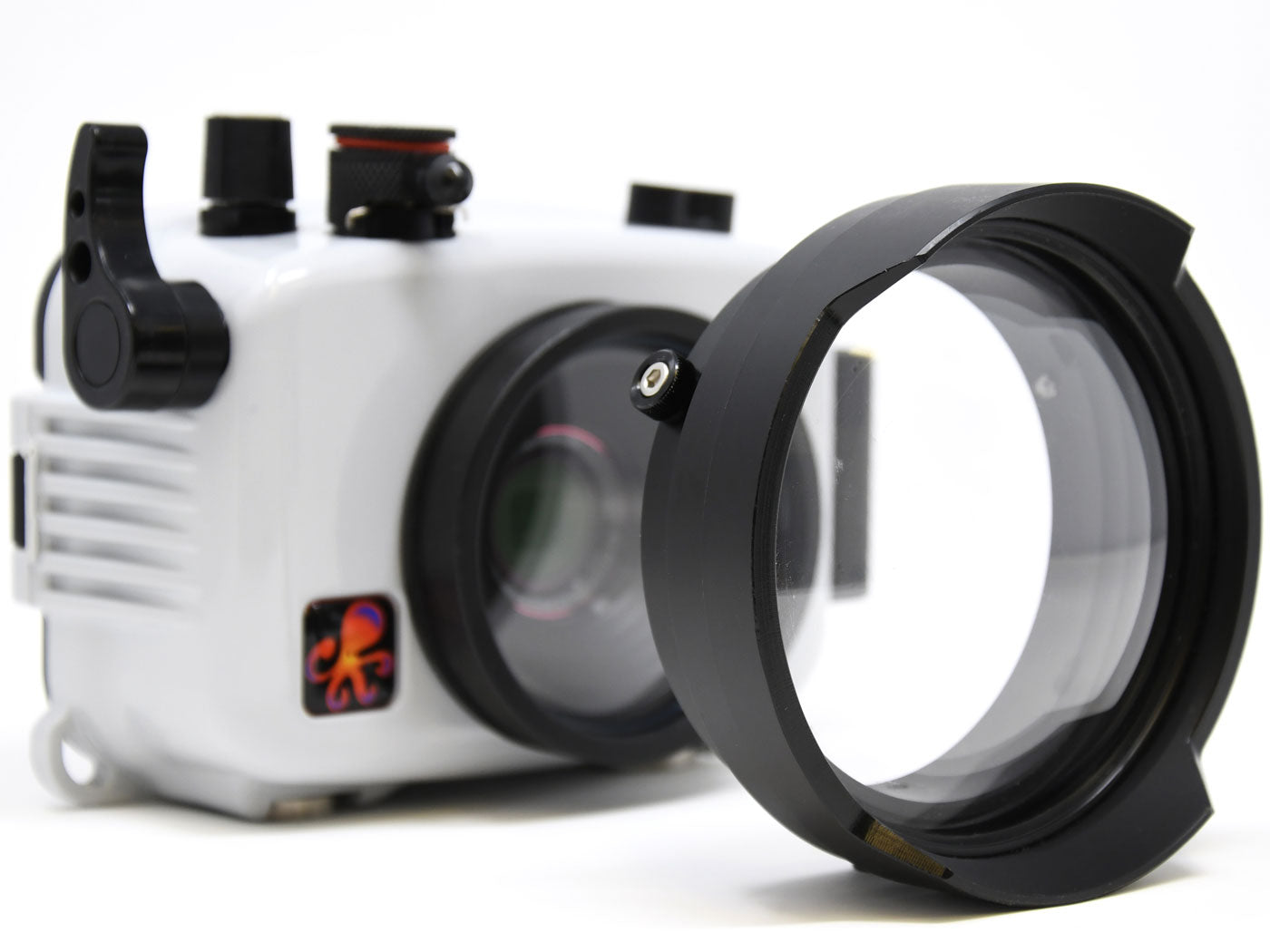
![Achieve a Perfectly Balanced Mirrorless or DSLR Housing [VIDEO]](http://www.ikelite.com/cdn/shop/articles/trim-weight-jacques-de-vos_37475dc7-9f05-4eb3-97de-0ff74b9138ea.jpg?v=1645897297&width=2000)